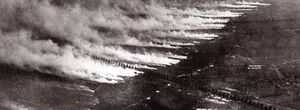Social:Timeline of chemical warfare
Chemical warfare is "the use of toxic chemicals in battle."[1] The precise date of the first instances of chemical warfare is unknown, but scholars speculate that smoke have been used as an irritant in both battles and for hunting in prehistoric times. The first records of chemical warfare come from accounts of India in the fourth century BC, when Indian archers dipped their arrows in snake venom. In the same period, the use of smoke against enemies digging tunnels was first recorded in Greece and China.[2] The next several centuries witnessed more and more sophisticated applications of toxic smoke and poisons in warfare.[3]
In the Middle Ages and the early modern period, chemical warfare advanced along with the development of chemistry. In 1456, during the Siege of Belgrade, an alchemist created poison clouds by burning rags that may have contained chlorine gas. In the fifteenth century, Leonardo da Vinci designed explosive shells filled with arsenic and sulfur for use against ships, and in the nineteenth century,[4] Thomas Cochrane advocated the use of burning sulfur as a naval weapon.[5] Later in the nineteenth century, the Union Army in the American Civil War devised plans to attack Confederate trenches with hydrochloric acid and sulfur acid, but failed to carry out its intentions.[6]
In the late nineteenth century, advances in organic chemistry led to the development of advanced new chemical weapons, such as mustard gas. These weapons were first used during World War I in which the belligerents used more than 125,000 tons of chemical munitions.[7] Despite great public opposition to chemical warfare after World War I, its development and practice continued. In the 1930s, Italy used chemical weapons during the Second Italo-Abyssinian War.[8] At the same time, German chemists discovered a new class of chemical weapons, far more deadly than early agents, nerve agents.[9]
During World War II, Japan used chemical weapons during the Second Sino-Japanese War,[10] but chemical weapons were not used on a large scale in the European theater or in conflict between the United States and Japan.[11] After the war, though, chemical weapons were used in several conflicts, most notably in the Yemeni Civil War and Iran–Iraq War. During this period, the United States and the Soviet Union also continued to refine their chemical arsenals, developing new agents such as VX and binary chemical weapons.
In 1993, the Chemical Weapons Convention was signed, outlawing all uses of chemical weapons in war. Since the signing of the convention, there have been numerous incidents of chemical weapons use, including by states parties to the convention.
In prehistory and myth
| Location | Event | Details | Ref |
|---|---|---|---|
| Greece | Labors of Heracles | According to Greek myth, Heracles killed the Lernaean Hydra then dipped his arrows in its venom in order to make them more deadly. | [12] |
| Greece | Trojan War | According to the Iliad, the Greeks led by Odysseus made use of poison arrows, as did the Trojans. Achilles is said to have been killed by a poison arrow shot at his heel. | [13] |
Ancient history
| Year | Location | Event | Details | Ref |
|---|---|---|---|---|
| c. 590 BC | Greece | First Sacred War | During the siege of Kirra, members of the Amphictionic League poisoned the city's water supply with hellebore. | [14] |
| 429 BC | Greece | Peloponnesian War | During the siege of Platea, the Spartans burned sulfur to create toxic gases (sulfur dioxide[15] and sulfur trioxide,[16] both pulmonary agents due to their tendency to react with water in lungs to produce sulfuric acid), leading the Plateans to abandon their posts. | [17] |
| c. 326 BC | India | Invasion of India | During the invasion of India, the Harmatelians (who lived near what is now Mansura, Pakistan) attacked the army of Alexander the Great with poison arrows, possibly dipped in cobra venom. | [18] |
World War I
With the advent of industrialised warfare in World War I the use of gas saw its first widespread use.
| Date | Location | Event | Details | Ref |
|---|---|---|---|---|
| 22 April 1915 | Ypres, Belgium | Second Battle of Ypres | The first successful mass use by Germany of poison gas | [19] |
| 12 July 1917 | Ypres Salient | Battle of Passchendaele | The First time Mustard gas is used by the Germans | [20] |
References
- ↑ Croddy, Chemical Warfare, p. 85
- ↑ Croddy, Chemical Warfare, p. 86
- ↑ Coleman, p. 6
- ↑ Coleman, p. 7
- ↑ COleman, p. 7–8
- ↑ Coleman, p. 9
- ↑ Croddy, World War I, p. 329
- ↑ Coleman, p. 47
- ↑ Croddy (2002), p. 109
- ↑ McCarthy, pp. 169–170
- ↑ Coleman, p. 60
- ↑ Mayor, p. 44
- ↑ Mayor, pp. 50–54
- ↑ Mayor, p. 100-101
- ↑ Sulfur
- ↑ Sulfur
- ↑ Mayor, pp. 210–211
- ↑ Mayor, p. 89
- ↑ Fetzer (Editor), p.366
- ↑ Hutchinson
Books cited
- Hutchinson, Robert (2003). Weapons of Mass Destruction: The No-Nonsense Guide to Nuclear, Chemical and Biological Weapons Today. George Weidenfeld & Nicolson. ISBN 9780297830917. https://archive.org/details/weaponsofmassdes0000hutc.
- Fetzer(Editor), Scott (1987). World Book w-x-y-z 21 (1988 ed.). World Book INC. ISBN 0-7166-0080-3.
- Coleman, Kim (2005). A History of Chemical Warfare. Palgrave MacMillan. ISBN 978-1-4039-3460-4.
- Croddy, Eric; Perez-Armendariz, Clarissa; Hart, John (2002). Chemical and Biological Warfare: A Comprehensive Survey for the Concerned Citizen. Copernicus Books. ISBN 0-387-95076-1. https://archive.org/details/chemicalbiologic00crod.
- Croddy, Eric (2005). "Chemical Warfare". in Croddy, Eric; Wirtz, James; Larsen, Jeffrey. Weapons of Mass Destruction: An Encyclopedia of Worldwide Policy, Technology and History. Santa Barbara: ABC-CLIO. ISBN 1-85109-490-3.
- Croddy, Eric (2005). "World War I: Chemical Warfare". in Croddy, Eric; Wirtz, James; Larsen, Jeffrey. Weapons of Mass Destruction: An Encyclopedia of Worldwide Policy, Technology and History. Santa Barbara: ABC-CLIO. ISBN 1-85109-490-3.
- Mayor, Adrienne (2003). Greek Fire, Poison Arrows, and Scorpion Bombs: Biological and Chemical Warfare in the Ancient World. Woodstock, NY: Overlook Duckworth. ISBN 1-58567-348-X.



